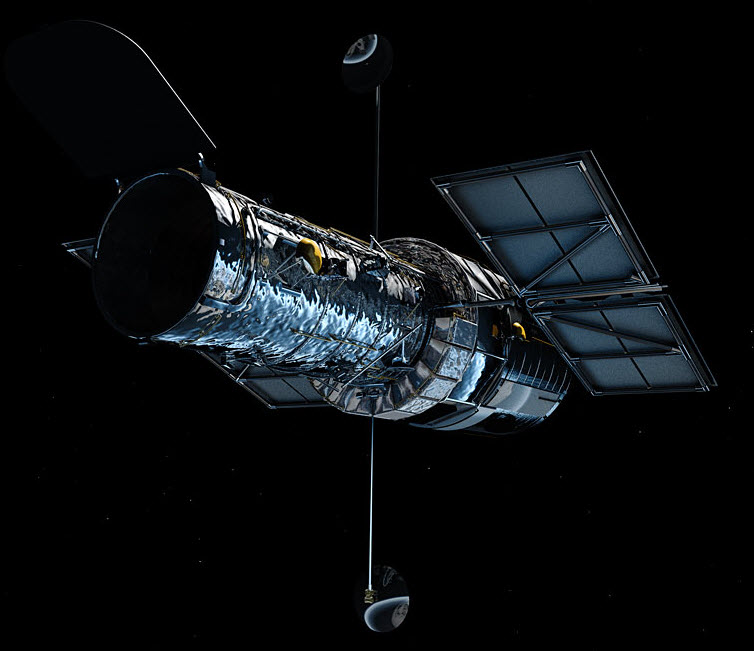First detection of super-Earth atmosphere
February 17, 2016
ESA/Hubble, M. Kornmesser | Transit of 55 Cancri e
Astronomers have analyzed the atmosphere of a “super-Earth” exoplanet for the first time, according to The Hubble Space Telescope project, an international cooperation between ESA and NASA. Result: it’s mostly hydrogen and helium.
The data gathered with the NASA/ESA Hubble Space Telescope and new analysis techniques also revealed that exoplanet 55 Cancri e has a dry atmosphere without any indications of water vapor.
The results will be published in the Astrophysical Journal (also available on open-source arXiv).
Exoplanet 55 Cancri e has a mass of eight Earth-masses* and is located in the planetary system of 55 Cancri, a star about 40 light-years from Earth.

This artist’s concept shows the NASA/ESA Hubble Space Telescope in orbit around the Earth. (credit: ESA/Hubble (M. Kornmesser))
“This is a very exciting result because it’s the first time that we have been able to find the spectral fingerprints that show the gases present in the atmosphere of a super-Earth,” explains Angelos Tsiaras, a PhD student at UCL, who developed the analysis technique along with his colleagues Ingo Waldmann and Marco Rocchetto.
“The observations of 55 Cancri e’s atmosphere suggest that the planet has managed to cling on to a significant amount of hydrogen and helium from the nebula from which it originally formed.”
Super-Earths like 55 Cancri e are thought to be the most common type of planet in our galaxy. They acquired the name ‘super-Earth’ because they have a mass larger than that of the Earth but are still much smaller than the gas giants in the Solar System.
55 Cancri e, however, is an unusual super-Earth as it orbits very close to its parent star. A year on the exoplanet lasts for only 18 hours and temperatures on the surface are thought to reach around 2000 degrees Celsius. Because the exoplanet is orbiting its bright parent star at such a small distance, the team was able to use new analysis techniques to extract information about the planet, during its transits in front of the host star.
Observations were made by scanning the WFC3 very quickly across the star to create a number of spectra. By combining these observations and processing them through analytic software, the researchers were able to retrieve the spectrum of 55 Cancri e embedded in the light of its parent star.
* 55 Cancri e has previously been dubbed the “diamond planet” because models based on its mass and radius have led to the idea that its interior is carbon-rich.
Abstract of Detection of an atmosphere around the super-Earth 55 Cancri e
We report the analysis of two new spectroscopic observations of the super-Earth 55 Cancri e, in the near infrared, obtained with the WFC3 camera onboard the HST. 55 Cancri e orbits so close to its parent star, that temperatures much higher than 2000 K are expected on its surface. Given the brightness of 55 Cancri, the observations were obtained in scanning mode, adopting a very long scanning length and a very high scanning speed. We use our specialized pipeline to take into account systematics introduced by these observational parameters when coupled with the geometrical distortions of the instrument. We measure the transit depth per wavelength channel with an average relative uncertainty of 22 ppm per visit and find modulations that depart from a straight line model with a 6σ confidence level. These results suggest that 55 Cancri e is surrounded by an atmosphere, which is probably hydrogen-rich. Our fully Bayesian spectral retrieval code, T-REx, has identified HCN to be the most likely molecular candidate able to explain the features at 1.42 and 1.54μm. While additional spectroscopic observations in a broader wavelength range in the infrared will be needed to confirm the HCN detection, we discuss here the implications of such result. Our chemical model, developed with combustion specialists, indicates that relatively high mixing ratios of HCN may be caused by a high C/O ratio. This result suggests this super-Earth is a carbon-rich environment even more exotic than previously thought.